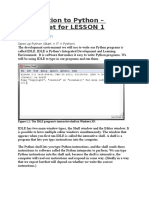0 ratings0% found this document useful (0 votes)
14 viewsPython - 2. The Input Function
The input() function prints a prompt and returns text entered by the user, allowing input. It can pause a program until enter is pressed. The text returned is a string, so int() or float() must convert it for calculations. An example program prompts for a name and prints a greeting.
Uploaded by
luxiusgamer47Copyright
© © All Rights Reserved
We take content rights seriously. If you suspect this is your content, claim it here.
Available Formats
Download as PDF, TXT or read online on Scribd
0 ratings0% found this document useful (0 votes)
14 viewsPython - 2. The Input Function
The input() function prints a prompt and returns text entered by the user, allowing input. It can pause a program until enter is pressed. The text returned is a string, so int() or float() must convert it for calculations. An example program prompts for a name and prints a greeting.
Uploaded by
luxiusgamer47Copyright
© © All Rights Reserved
We take content rights seriously. If you suspect this is your content, claim it here.
Available Formats
Download as PDF, TXT or read online on Scribd
You are on page 1/ 1
The input() function
input(prompt)
The function input(prompt) prints the message 'prompt' to the screen and returns a line of
text typed by the user with the keyboard.
This function can be used to stop the program from running until the 'Enter' key or the
'Return' key is pressed.
Examples:
Notice how the number entered is a text string, so we cannot perform calculations with it. To
convert the text into a number you must use one of the following functions:
● int('') converts a text string to an integer (no decimals)
● float('') converts a text string to a floating point number.
Exercise:
Write a program that prompts for your name on the screen and then prints a personalized
greeting with your name.
You might also like
- Grade 6 Programming the Computer (4.2 My First Program )No ratings yetGrade 6 Programming the Computer (4.2 My First Program )6 pages
- 2_1_Console IO, Variables, Data Types (1)No ratings yet2_1_Console IO, Variables, Data Types (1)40 pages
- Week 2, Python Comments, input, Data type convert, if elseNo ratings yetWeek 2, Python Comments, input, Data type convert, if else85 pages
- 04python 04 Getting Inputs From The User in PythonNo ratings yet04python 04 Getting Inputs From The User in Python10 pages
- 82-Till End Getting Started With Python and Python Fundamentals OnlineNo ratings yet82-Till End Getting Started With Python and Python Fundamentals Online74 pages
- 004 - 14-05-2020 XI-Python Basics - Programming #2No ratings yet004 - 14-05-2020 XI-Python Basics - Programming #231 pages
- The Input Function: My - Age ( (My - Age) )No ratings yetThe Input Function: My - Age ( (My - Age) )1 page
- Python Notes by Rishabh Mishra Chap-07-Input FunctionNo ratings yetPython Notes by Rishabh Mishra Chap-07-Input Function3 pages



























































